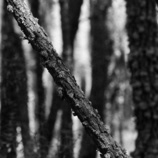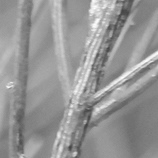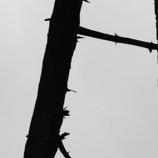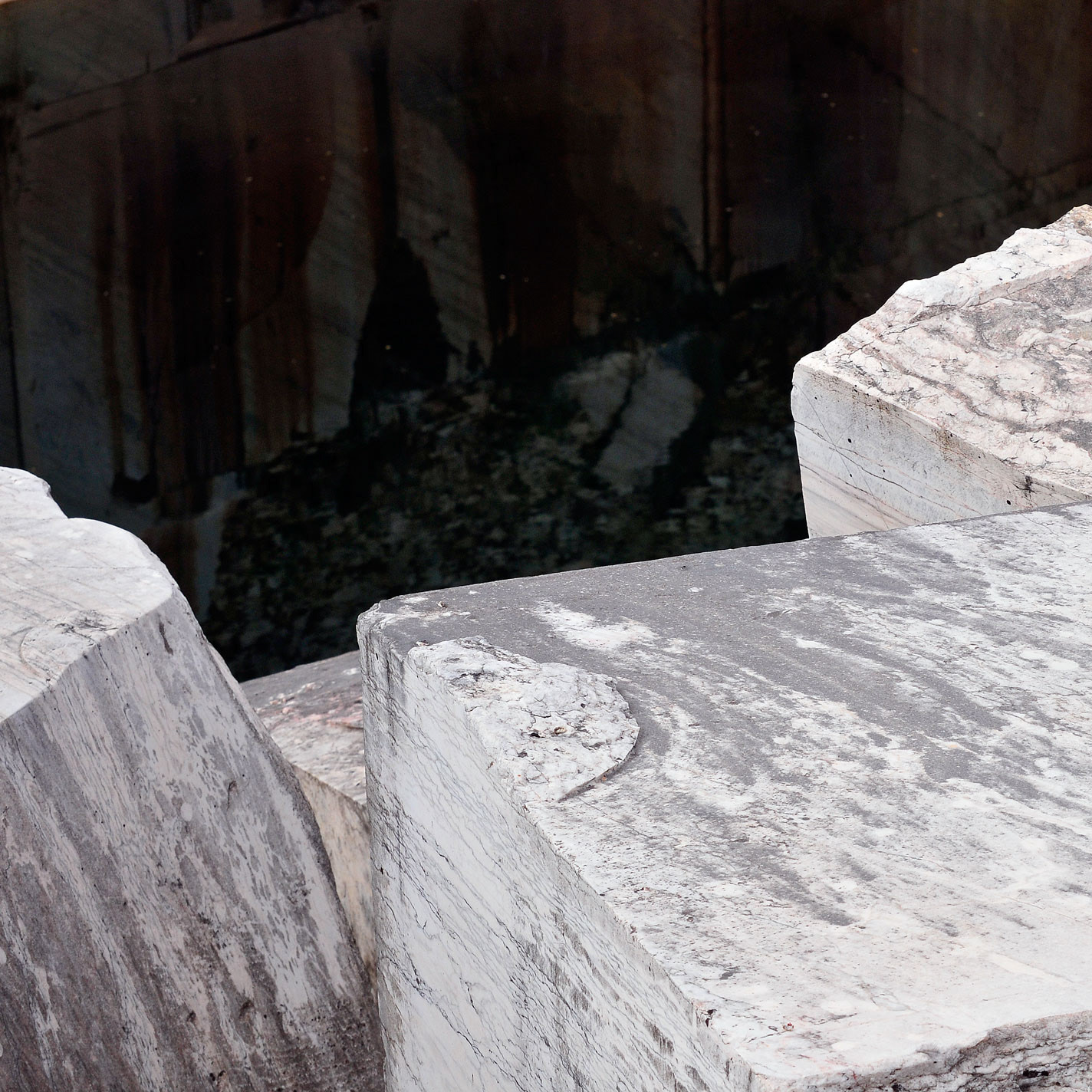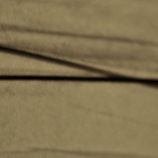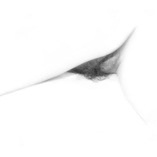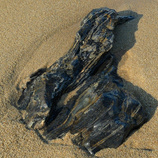Faça-se a luz!
Deus
Do mistério inicial inerente a todas as coisas que não existem emana, sempre, a emoção da viagem, do desconhecido, o alvoroço característico da partida.
O trabalho que aqui apresento nasceu do repto lançado pela Colquímica. Pediam-me que criasse uma “coleção” de imagens que refletisse a minha interpretação plástica de uma matéria habitualmente utilizada como integrante de múltiplas indústrias: a cola.
Quis entendê-la, eu também, como componente primária da “produção” artística que viria a criar. Queria gerar matéria visual que, embora nascida num berço tecnológico e industrial, permitisse incorporar uma leitura poética que estimulasse os futuros olhadores a partir para uma viagem devoluta de conceitos pré-fabricados.
Optei por indeterminar o meu ponto de chegada: seria exatamente esse o ponto de partida para os “meus” olhadores. Sabia que o meu cais de embarque se situaria algures dentro do departamento de produção de uma fábrica visualmente austera. No fundo, seria eu o responsável pelos adereços. Teria apenas que saber encontrá-los. Dentro de enormes caldeiras, empilhados em paletes, embrulhados em finas películas protetoras
ou encaminhados, já, ao departamento de reciclagem onde seriam “rejuvenescidos” e reutilizados. Na verdade, começava aqui a minha viagem: teria que encontrar com os meus olhos aquilo que viria a transformar em “alimento” para os olhos de outros. Sentia-me garimpeiro em busca de pepitas em estado bruto. Sabia, apenas, que seria de luz o meu caminho, seria com ela que teria que modelar massas homogéneas, atravessar
transparências, desenhar formas inusitadas...
Porém, ao contrário de qualquer outro viajante de longo curso, carecia de mapas ou cartas náuticas que me indicassem a trajetória da viagem. Nenhum sextante, GPS, ou sequer uma bússola que me orientasse a viagem sem destino determinado. Apenas algumas amarras de serventia me obrigavam, pontualmente, a aferir a rota.
Muitas emoções afetivas me acompanharam a solidão. Gente que conheci pelo caminho, ou velhos marujos, viajantes do meu viver, a eles quero mostrar, aqui, o meu agradecimento. Como viajantes que são, todos sabem quem são.
O diário de bordo está agora aqui. Servirá de registo mas, seguramente, também de ponto de abalada para outras viagens.
O trabalho que aqui apresento nasceu do repto lançado pela Colquímica. Pediam-me que criasse uma “coleção” de imagens que refletisse a minha interpretação plástica de uma matéria habitualmente utilizada como integrante de múltiplas indústrias: a cola.
Quis entendê-la, eu também, como componente primária da “produção” artística que viria a criar. Queria gerar matéria visual que, embora nascida num berço tecnológico e industrial, permitisse incorporar uma leitura poética que estimulasse os futuros olhadores a partir para uma viagem devoluta de conceitos pré-fabricados.
Optei por indeterminar o meu ponto de chegada: seria exatamente esse o ponto de partida para os “meus” olhadores. Sabia que o meu cais de embarque se situaria algures dentro do departamento de produção de uma fábrica visualmente austera. No fundo, seria eu o responsável pelos adereços. Teria apenas que saber encontrá-los. Dentro de enormes caldeiras, empilhados em paletes, embrulhados em finas películas protetoras
ou encaminhados, já, ao departamento de reciclagem onde seriam “rejuvenescidos” e reutilizados. Na verdade, começava aqui a minha viagem: teria que encontrar com os meus olhos aquilo que viria a transformar em “alimento” para os olhos de outros. Sentia-me garimpeiro em busca de pepitas em estado bruto. Sabia, apenas, que seria de luz o meu caminho, seria com ela que teria que modelar massas homogéneas, atravessar
transparências, desenhar formas inusitadas...
Porém, ao contrário de qualquer outro viajante de longo curso, carecia de mapas ou cartas náuticas que me indicassem a trajetória da viagem. Nenhum sextante, GPS, ou sequer uma bússola que me orientasse a viagem sem destino determinado. Apenas algumas amarras de serventia me obrigavam, pontualmente, a aferir a rota.
Muitas emoções afetivas me acompanharam a solidão. Gente que conheci pelo caminho, ou velhos marujos, viajantes do meu viver, a eles quero mostrar, aqui, o meu agradecimento. Como viajantes que são, todos sabem quem são.
O diário de bordo está agora aqui. Servirá de registo mas, seguramente, também de ponto de abalada para outras viagens.
Paulo Gaspar Ferreira
… e a luz fez-se.
Génesis 1, 3
__________________________________________________________________________________________
Let there be light!
God
God
From the primordial mystery, inherent to all things that there are not, emanates, always, the excitement of the journey, of the unknown, the typical unrest of departures.
The work presented here was born from the challenge posed by Colquímica. I was asked to create a “collection” of images that would reflect my artistic interpretation of a material that is used every day in multiple industries: glue.
I wanted to understand it myself, as the central object of the artistic “production” I was about to create. I wanted to generate visual matter, which, despite being born in a technological and industrial cradle, would allow a poetic interpretation that stimulates future beholders to set sail in a journey devoid of prefabricated concepts.
I chose to keep my point of arrival undefined: that would be precisely the starting point for ‘my’ beholders. I knew my boarding pier would be located somewhere within the production department of a visually austere factory. Essentially, I would be the one in charge of the props. I would only have to know where to find them. Inside huge boilers, stacked in pallets, wrapped in thin protective films or already forwarded to the recycling facilities, where they would be “rejuvenated” and reused. In fact, my journey began here: I would have to find with my own eyes that which I would turn into “food” for the eyes of others. I felt like a gold miner in search of nuggets in the rough. All I knew was that my path would be one of light, and it would be with that light that I would have to model homogeneous masses, move through transparencies, draw unusual shapes...
However, unlike any other long haul traveller, I lacked maps or charts that could guide the path of my journey. No GPS, no sextant, not even a compass to guide me in my journey to an unknown destination. Only a few practical restraints forced me to check my course from time to time.
Many affective emotions kept me company in my loneliness. People I met along the way, old sailors, travellers of my life, to them I wish to show my deepest acknowledgement. As travellers that they are, they all know who they are.
The logbook is here now. It will stand as a record, but, surely, also a starting point for other journeys.
Paulo Gaspar Ferreira
... and there was light.
Genesis 1, 3
____________________________________________________________________________________
Plasticidades
O tempo é a imagem móvel da eternidade
Platão
Tempo e forma são categorias essenciais em qualquer cultura. Ambas estão associadas à materialidade dos fenómenos percetíveis e, em especial, àqueles aos quais acedemos através da visão. Mas o tempo é fluxo e não forma. É percetível e não visível. Podemos medi-lo em sua duração,
embora não possamos ver, ouvir, cheirar, provar e muito menos tocar a sua existência. Podemos figurá-lo na sua universalidade, embora não possamos sentir ou abarcar todas as suas múltiplas dimensões. Entre as imagens criadas pelo homem para representar o tempo, há figurações já muito conhecidas para lhe dar uma aparência física, de ser ou coisa: a seta, o círculo, a ampulheta, o relógio, o calendário, o velho e a foice, e assim por diante. Este livro e suas imagens levam-nos a descobrir muitas outras figurações possíveis para o tempo e a sua plasticidade.
embora não possamos ver, ouvir, cheirar, provar e muito menos tocar a sua existência. Podemos figurá-lo na sua universalidade, embora não possamos sentir ou abarcar todas as suas múltiplas dimensões. Entre as imagens criadas pelo homem para representar o tempo, há figurações já muito conhecidas para lhe dar uma aparência física, de ser ou coisa: a seta, o círculo, a ampulheta, o relógio, o calendário, o velho e a foice, e assim por diante. Este livro e suas imagens levam-nos a descobrir muitas outras figurações possíveis para o tempo e a sua plasticidade.
Do Homo Neanderthalensis, espécie extinta que habitou a Europa e partes da Ásia há cerca de 300.000 anos, ao “homo internauta” que hoje navega pelo planeta web, há uma substância pouco lembrada pelos historiadores da cultura material que foi capaz de sobreviver à transição entre essas duas épocas, tão distintas e tão longínquas entre si. Esta substância é a cola. Natural ou sintética, fluida, viscosa ou rígida, a cola tem origem e razão de ser na eterna necessidade humana de unir o que está separado pela natureza ou pelo destino. Por isto mesmo, a história da cola é também a história de uma das mais fascinantes descobertas do homem ou, mais precisamente, do modo como empregamos essa descoberta para inventar novas combinações, colagens, reações, texturas, aparências e formas, em todos os segmentos das nossas vidas.
Desde os primórdios da história da fotografia, as coisas materiais e corpóreas, adesivas ou não, tanto quanto as substâncias do espírito, sensoriais e subjetivas, têm sido, cada qual a seu modo, matéria-prima da criação imagética. Na fotografia, antes analógica e agora digital, como na poesia de todos os tempos, a maleabilidade da forma possibilita ao criador sensível e ao observador perspicaz a captação de luminosidades, sombreamentos, texturas, ondulações, riscos, gotas, sulcos, fluxos, escorrimentos, instantes e permanências. Com infindáveis combinações de movimento e forma, o artista recria as “imperfeições da existência humana” que, afinal, também representam o tempo.
Paulo Gaspar Ferreira é um hábil desenhador de letras e formas. Mas é também um “escultor de fotografias”. As suas criações são inusitadas, surpreendentes, admiráveis. É fácil constatá-lo... E não somente nas imagens que aqui se oferecem à nossa visão. Em trabalhos anteriores, ele já nos levou à fruição, por vezes desconcertante, de prosaicas fotografias de folhas, algas, sementes, musgos, pelos, corpos (e o que mais pudermos imaginar...). Essas imagens, mais abstratas que realistas, encontram a sua forma poética justamente na separação mental que somos conduzidos a fazer entre os diversos elementos de uma totalidade.
Por esta razão, as fotografias de Paulo são pedaços de “coisas” que se perenizam por estarem
deslocadas daquela totalidade complexa (ser, matéria, fato) que lhes serviu de inspiração. Podemos espreitá-las, admirá-las e quase tocá-las nos seus livros-objeto que mais se assemelham a esculturas do que a impressões bidimensionais. Livros que o artista, inspirado e inspirador, denominou Anima Vegetalis, Anima Sensualis, Espíritos Elementares.
Paulo Gaspar Ferreira é um hábil desenhador de letras e formas. Mas é também um “escultor de fotografias”. As suas criações são inusitadas, surpreendentes, admiráveis. É fácil constatá-lo... E não somente nas imagens que aqui se oferecem à nossa visão. Em trabalhos anteriores, ele já nos levou à fruição, por vezes desconcertante, de prosaicas fotografias de folhas, algas, sementes, musgos, pelos, corpos (e o que mais pudermos imaginar...). Essas imagens, mais abstratas que realistas, encontram a sua forma poética justamente na separação mental que somos conduzidos a fazer entre os diversos elementos de uma totalidade.
Por esta razão, as fotografias de Paulo são pedaços de “coisas” que se perenizam por estarem
deslocadas daquela totalidade complexa (ser, matéria, fato) que lhes serviu de inspiração. Podemos espreitá-las, admirá-las e quase tocá-las nos seus livros-objeto que mais se assemelham a esculturas do que a impressões bidimensionais. Livros que o artista, inspirado e inspirador, denominou Anima Vegetalis, Anima Sensualis, Espíritos Elementares.
Nesta obra que agora nos apresenta, Paulo Gaspar Ferreira empregou toda a sua criatividade e experiência como “escultor de fotografias” para reconfigurar na superfície plana uma abstração poética do tempo e da forma. As texturas e os matizes das diferentes substâncias adesivas, maleáveis e translúcidas, fixadas aleatoriamente pela fortuna ou pelo desejo do artista, são aqui exploradas em infindáveis combinações. Substância naturalmente plástica, cuja aparência tende a se modificar a partir de condições internas e externas, a cola traz na sua composição o enigma do tempo e da forma, de modo que a plasticidade dessas transformações, materializando a duração do fluxo temporal, exprime uma visualidade com forte apelo poético. Pois, para quem duvidar que resíduos, fluxos, evaporações, solvências e outras reações químicas podem conter, no conteúdo e na forma, alguma poesia, aí estão as fotografias de Paulo Gaspar Ferreira para nos mostrar o contrário. Melhor dizendo, para nos seduzir com muita poesia. Aquela, justamente, que desperta em cada um de nós o elevado sentimento do belo.
Maria Inez Turazzi
Maria Inez Turazzi vive no Rio de Janeiro. Historiadora e doutora em arquitetura e urbanismo, é curadora de artes visuais, tendo publicado diversos artigos e livros, no Brasil e no exterior. Em 2012, trabalhando como pesquisadora visitante da Universidade de Lisboa, conheceu Paulo Gaspar Ferreira, suas fotos e seus livros, ocasião na qual aderiu ao projeto desta obra.
______________________________________________________________________
Plasticities
Time and form are essential categories in any culture. Both are associated with the materiality of perceptible phenomena and, in particular, to those which we access through sight. But time is flow, not form. It is perceptible and not visible. We can measure its duration, but we cannot see, hear, smell or taste it, much less touch its existence. We can perceive it in its universality, but we cannot feel or comprehend all its multiple dimensions. Among the images created by Man to represent time, there are widely known allegories attempting to give it a physical appearance, of a being or a thing: the arrow, the circle, the hourglass, the clock, the calendar, the grim reaper, and so on. This book and its images take
us on a discovery of many other possible representations of time and its plasticity.
us on a discovery of many other possible representations of time and its plasticity.
From the Homo Neanderthalensis, an extinct species that inhabited Europe and parts of Asia about 300,000 years ago, to the “homo netizen” who, nowadays, navigates planet web, there is a substance, little remembered by historians of material culture, that was able to survive the transition between these two periods, so different and so distant from each other. This substance is glue. Natural or synthetic, fluid, viscous or rigid, the origin and the reason for the existence of glue is the eternal human need to unite what is separated by nature or fate. For this reason, the history of glue is also the history of one of Man’s most fascinating discoveries or, more precisely, of the way we use this discovery to invent
new combinations, collages, reactions, textures, appearances and shapes, across all segments of our lives.
new combinations, collages, reactions, textures, appearances and shapes, across all segments of our lives.
Since the early history of photography, corporeal and material things, adhesive or not, much like the substances of the spirit, sensorial and subjective, have been, each in its own way, the raw material of imagery creation. In photography, first analogue and now digital, as in the poetry of all eras, the malleability of form enables the sensitive creator and the perceptive observer to capture luminosities, shades, textures, ripples, scratches, drops, ridges, flows, run-offs, instants and permanencies. With endless combinations of movement and shapes, the artist recreates the “imperfections of human existence” which, after all, also represent time.
Paulo Gaspar Ferreira is a skilled designer of letters and shapes. But he is also a “sculptor of photographs”. His creations are unusual, amazing, admirable. It is easy to see it... Not only in the images displayed here. In his previous works, he has led us to the fruition, sometimes in bewilderment,
of prosaic photographs of leaves, algae, seeds, moss, hair, bodies (and whatever we may imagine...). These images, more abstract than realistic, find their poetic form precisely in the mental separation that we are led to make between the various elements of a whole. For this reason, Paul’s photographs are pieces of “things” that become eternal by being removed from that complex whole (being, matter, fact)
that inspired them. We glance at them, admire them and almost touch them in their books-objects that resemble more sculptures than twodimensional prints. Books that the artist, inspired and inspiring, has named Anima Vegetalis, Anima Sensualis and Espíritos Elementares.
of prosaic photographs of leaves, algae, seeds, moss, hair, bodies (and whatever we may imagine...). These images, more abstract than realistic, find their poetic form precisely in the mental separation that we are led to make between the various elements of a whole. For this reason, Paul’s photographs are pieces of “things” that become eternal by being removed from that complex whole (being, matter, fact)
that inspired them. We glance at them, admire them and almost touch them in their books-objects that resemble more sculptures than twodimensional prints. Books that the artist, inspired and inspiring, has named Anima Vegetalis, Anima Sensualis and Espíritos Elementares.
In this work, Paulo used all his creativity and experience as a “sculptor of photographs” to reconfigure, on a flat surface, a poetic abstraction of time and form. The textures and hues of the different adhesive substances, soft and translucent, randomly captured by fortune or by the artist’s will, are explored in endless combinations. A naturally plastic substance, whose appearance tends to change according to internal and external conditions, glue includes in its composition the puzzle of time and form and, thus, the plasticity of these transformations, materializing theduration of the temporal flux, expresses a visual manifestation with a strong poetic appeal. For those who doubt that residues, flows, evaporation,
solvency and other chemical reactions may contain, in content and form, some kind of poetry, here are the photographs of Paulo Gaspar Ferreira to prove otherwise. In other words, to seduce us with a lot of poetry. That one which can awaken in each of us a keen sense of beauty.
solvency and other chemical reactions may contain, in content and form, some kind of poetry, here are the photographs of Paulo Gaspar Ferreira to prove otherwise. In other words, to seduce us with a lot of poetry. That one which can awaken in each of us a keen sense of beauty.
Maria Inez Turazzi
Maria Inez Turazzi lives in Rio de Janeiro. As an historian with a PhD in architecture and urbanism, she is a visual arts curator and has published several articles and books, in Brazil and abroad. In 2012, while working as a visiting researcher at the University of Lisbon, she met Paulo Gaspar Ferreira, his photos and works, occasion upon which she joined this project.
